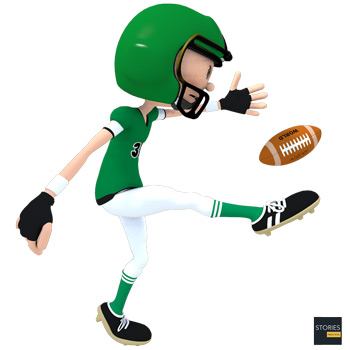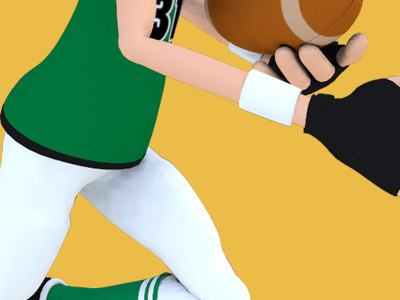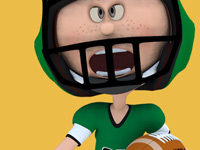American football

Punter (P)
A punter (P) in American or Canadian football is a special teams player who receives the snapped ball directly from the line of scrimmage and then punts (kicks) the football to the opposing team so as to limit any field position advantage. This generally happens on a fourth down in American football and a third down in the Canadian version. Punters may also occasionally take part in fake punts in those same situations, when they throw or run the football instead of punting.
Skills
A punter must be skilled in angling the football and/or kicking it as high as possible (called "hangtime") to maximize his teammates’ ability to eliminate a punt returner's forward progress. A "standard" is that for a 42-yard fair-caught or out-of-bounds punt (without added yardage with the ball rolling on the ground), the ideal hang time should be at least a tenth of it in seconds (i.e. 4.20 seconds), but the linear relationship drops off once it hits over 50 yards. However, a hang-time of 5 seconds and over are still considered great punts. Also, the punter will try to make the ball spin in an unusual manner making it harder to catch, which could result in a muff and potentially lead to the punter's team gaining possession.
The most common punting strategy involves receiving the snap from the line of scrimmage, 15 yards (if not shortened to avoid the end line) into an extremely deep shotgun formation, then punting as soon as the snap is received. A less-seen strategy is the "rugby-style" kick, in which the punter moves to the left or right, outside the offensive tackle, and then kicks the ball.
Punters play a major role in winning the field position battle. Punters have increasingly begun to pull double duty as the holder on field goal attempts and also being used on kickoffs in windy conditions. One of the main reasons why punters are starting to take over the holder position is that the backup quarterback is usually busy with the rest of the offense and has little time to devote to holding. Likewise the punter has certain training in throwing, due to the possibility of faking a field goal or attempting a two-point conversion. The long snapper for field goals is usually the punt snapper as well, so the punter already has developed a chemistry with the snapper and is used to catching a long-snapped ball.

Punters are also kickers and understand kicking mechanics better, such as knowing how far back to lean the ball as the kicker makes an attempt, and better at judging when a field goal attempt should be aborted. Punters are usually on their own during team practices, allowing them the time to work with the kicker, so the punter and placekicker tend to develop a close rapport. Many punters also double duty as kickoff specialists as most punters have been at one point field goal kickers as well, and some, such as Craig Hentrich, have filled in as worthy backup field goal kickers.
Punters seldom receive much attention or fan support, in part because their role is greatest when a team's offense is a failure and cannot get within field goal range; they are thus seen as a necessary evil to salvage the incompetence of the offense. Thus, punters tend to receive the most attention when teams are bad, as they are often one of the few players on the team performing up to par. However, punter can also serve to give defenses pressure to pin the opponents deep within their territory, so giving defenses a short field, or to eliminate the threat of a punt return touchdown by return specialists.
Coffin corner
A coffin corner refers to the corner of the playing field just in front of the end zone, usually from the 5-yard line to the goal line. A perfect coffin corner kick is one that goes out of bounds just before either orange pylon located in the front of the end zone. The punter tries to place the ball so that it lands out of bounds or is downed on the field by another member of the kicking team anywhere inside the 5-yard line without touching the goal line, thus forcing difficult field position for the receiving team on their next scrimmage.
The name arises by extension from the "coffin corner" found in Victorian houses (the slang and often refuted term used to describe a decorative niche, or very small 'corner', cut into the wall of a staircase landing), because the target area is very small. A high level of skill is required to execute such a punt, for if the kick is slightly too far into the end zone or if a member of the kicking team touches the goal line while maintaining possession of the ball, a touchback is awarded, losing the advantage that comes with a successful execution of the kick. If the ball goes out of bounds too far upfield, the receiving team will usually have more options on offense, such as being able to drop back for a pass without fear of possibly giving up a safety. More often than not, a kicker's attempt to land the ball accurately within the coffin corner fails, as the amount of skill required to angle a kick inside such a small area is extraordinary. In recent years, as punters have become more adept at kicking the ball so as to not bounce forward after landing, punting teams have increasingly eschewed coffin corner punts in favor of kicking inbounds and downing the ball before it reaches the end zone.
This type of kick can also be attempted in Canadian football. The difference is that if the ball becomes dead in the endzone in Canadian football, a single point is awarded to the kicking team and the conceding team scrimmages from their 35-yard line. In most cases however, the kicking team prefers the advantageous field position, rather than the point.
Career lengths
Certain punters can have exceptionally long careers, compared to other NFL position players (there is a similar phenomenon with kickers). One reason for this is that their limited time on the field and heavy protection by penalties against defensive players for late hits makes them far less likely to be injured than other positions. Sean Landeta, for instance, played 19 NFL seasons and three USFLseasons for eight different teams. Jeff Feagles of the New York Giants played 22 seasons as a punter.
Conversely, placekickers and punters can also have very short careers, mainly because of a lack of opportunity. Because the risk of injury is remote, NFL teams typically only carry one punter on their roster at any given time. Thus, the only opportunity a punter has of breaking into the league is if the incumbent punter leaves the team or is injured. Some NFL teams will carry two punters during the preseason, but the second punter is typically “camp fodder” and almost never makes the opening day roster. Unlike backups at other positions, backup placekickers and punters are not employed by any given team until they are needed; most indoor American football teams, because of smaller rosters and fields along with rules that either ban or discourage punting, do not employ punting specialists.
SPORTS



American Football
Game play in American football consists of a series of downs, individual plays of short duration, outside of which the ball is dead or not in play. These can be plays from scrimmage – passes, runs, punts, or field goal attempts (from either a place kick or a drop kick) – or free kicks such as kickoffs and fair catch kicks. Substitutions can be made between downs, which allows for a great deal of specialization as coaches choose the players best suited for each particular situation. During a play, each team should have no more than 11 players on the field, and each of them has specific tasks assigned for that specific play.
Rules and gameplay
- Scoring
- Maneuvers
- Strategy
- Play types
- Penalties
- Turnovers
- Downs
- Teams and positions
- Field
- Equipment
- Duration and time stoppages
- Advancing the ball and downs
- Kicking
- Officials and fouls
Positions
Offensive (Interior) line
Backs and receivers
Defensive line
Linebackers
Defensive backs
Special teams
- Kicker (K)
- Holder (H)
- Long snapper (LS)
- Punter (P)
- Kickoff specialist (KOS)
- Kick returner (KR) and Punt returner (PR)
- Upback
- Gunner
- Jammer


RESOURCES
This article uses material from the Wikipedia articles "American football", "American football positions" and "Punter (football)", which is released under the Creative Commons Attribution-Share-Alike License 3.0.
© Stories Preschool. All Rights Reserved.





